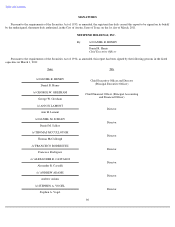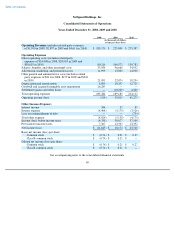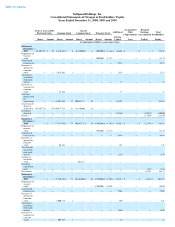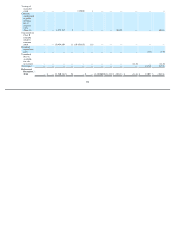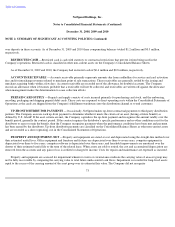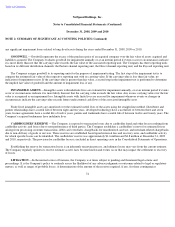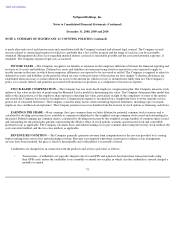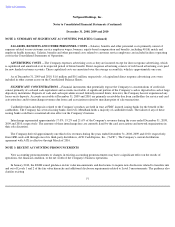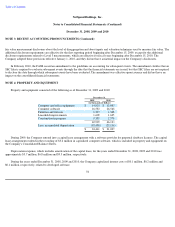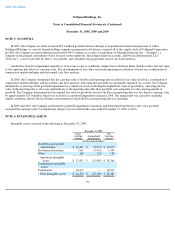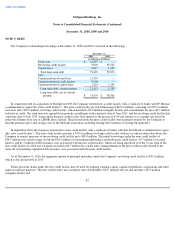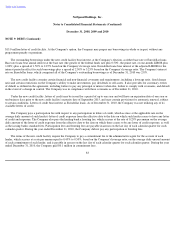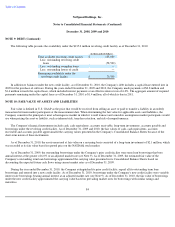NetSpend 2010 Annual Report Download - page 80
Download and view the complete annual report
Please find page 80 of the 2010 NetSpend annual report below. You can navigate through the pages in the report by either clicking on the pages listed below, or by using the keyword search tool below to find specific information within the annual report.
Table of Contents
NetSpend Holdings, Inc.
Notes to Consolidated Financial Statements (Continued)
December 31, 2008, 2009 and 2010
NOTE 2: SUMMARY OF SIGNIFICANT ACCOUNTING POLICIES (Continued)
any significant impairment losses related to long-lived assets during the years ended December 31, 2008, 2009 or 2010.
GOODWILL —Goodwill represents the excess of the purchase price of an acquired company over the fair value of assets acquired and
liabilities assumed. The Company evaluates goodwill for impairment annually or at an interim period if events occur or circumstances indicate
it is more likely than not that the carrying value exceeds the fair value of the associated reporting unit. The Company has three reporting units
based on its different distribution channels: the Partner channel reporting unit, the Direct channel reporting unit, and the Paycard reporting unit.
The Company assigns goodwill to its reporting units for the purpose of impairment testing. The first step of the impairment test is to
compare the estimated fair value of the respective reporting unit with its carrying value. If the carrying value is less than fair value, no
indication of impairment exists. If the carrying value is greater than fair value, a second step in the impairment test is performed to determine
the implied fair value of goodwill and the amount of impairment loss, if any.
INTANGIBLE ASSETS —Intangible assets with indefinite lives are evaluated for impairment annually, or at an interim period if events
occur or circumstances indicate it is more likely than not that the carrying value exceeds the fair value. Any excess carrying value over the fair
value is recognized as an impairment loss. Intangible assets with finite lives are assessed for impairment whenever events or changes in
circumstances indicate the carrying value exceeds future undiscounted cash flows of the associated intangible asset.
Finite lived intangible assets are amortized over the estimated useful lives of the assets using the straight-line method. Distributor and
partner relationships have a useful life of between eight and ten years, developed technology have a useful life of between three and seven
years, license agreements have a useful life of twelve years, patents and trademarks have a useful life of between twelve and twenty years. The
Company's acquired tradenames have indefinite lives.
CARDHOLDERS' RESERVE —The Company is exposed to transaction losses due to cardholder fraud and other losses resulting from
cardholder activity, and losses due to non-performance of third parties. The Company establishes a cardholders' reserve for estimated losses
arising from processing customer transactions, debit card overdrafts, chargebacks for unauthorized card use, and merchant-related chargebacks
due to non-delivery of goods or services. These reserves are established based upon historical loss and recovery rates, and cardholder activity
for which specific losses can be identified. The cardholders' reserve was approximately $1.6 million and $4.8 million at December 31, 2009
and 2010, respectively. The provision for cardholder losses is included in direct operating costs in the Consolidated Statements of Operations.
Establishing the reserve for transaction losses is an inherently uncertain process, and ultimate losses may vary from the current estimate.
The Company regularly updates its reserve estimate as new facts become known and events occur that may impact the settlement or recovery
of losses.
LITIGATION —In the normal course of business, the Company is at times subject to pending and threatened legal actions and
proceedings. It is the Company's policy to routinely assess the likelihood of any adverse judgments or outcomes related to legal or regulatory
matters, as well as ranges of probable losses. A determination of the amount of the reserves required, if any, for these contingencies
74


